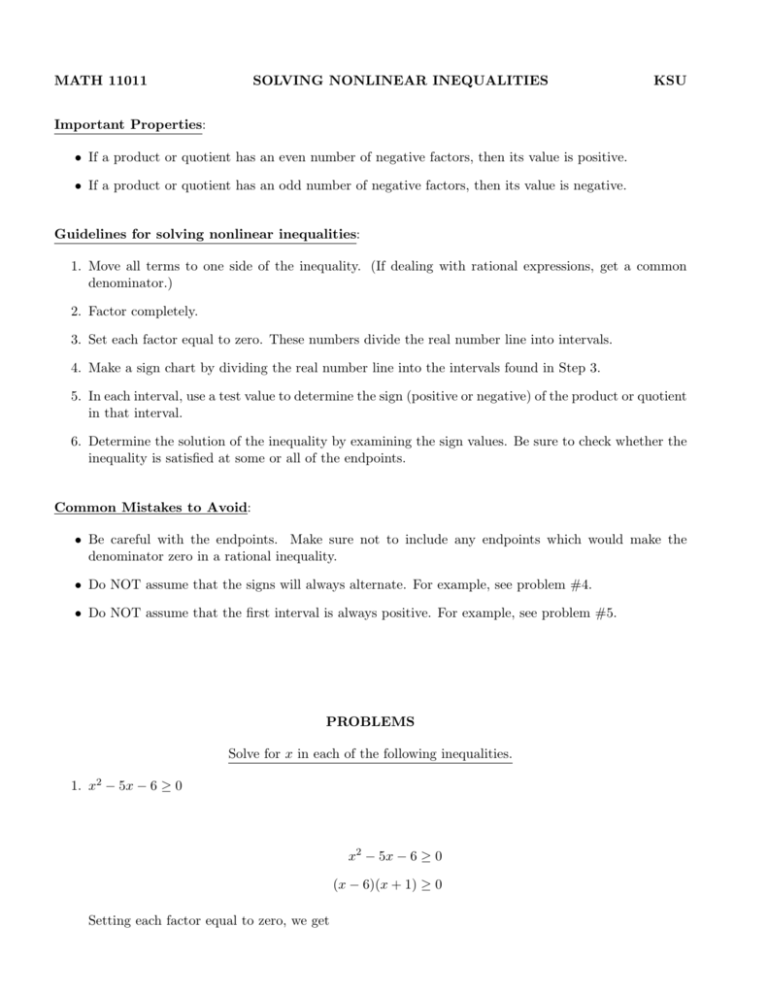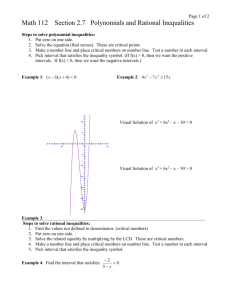Solving nonlinear inequalities
advertisement

MATH 11011 SOLVING NONLINEAR INEQUALITIES KSU Important Properties: • If a product or quotient has an even number of negative factors, then its value is positive. • If a product or quotient has an odd number of negative factors, then its value is negative. Guidelines for solving nonlinear inequalities: 1. Move all terms to one side of the inequality. (If dealing with rational expressions, get a common denominator.) 2. Factor completely. 3. Set each factor equal to zero. These numbers divide the real number line into intervals. 4. Make a sign chart by dividing the real number line into the intervals found in Step 3. 5. In each interval, use a test value to determine the sign (positive or negative) of the product or quotient in that interval. 6. Determine the solution of the inequality by examining the sign values. Be sure to check whether the inequality is satisfied at some or all of the endpoints. Common Mistakes to Avoid: • Be careful with the endpoints. Make sure not to include any endpoints which would make the denominator zero in a rational inequality. • Do NOT assume that the signs will always alternate. For example, see problem #4. • Do NOT assume that the first interval is always positive. For example, see problem #5. PROBLEMS Solve for x in each of the following inequalities. 1. x2 − 5x − 6 ≥ 0 x2 − 5x − 6 ≥ 0 (x − 6)(x + 1) ≥ 0 Setting each factor equal to zero, we get Solving Nonlinear Inequalities, page 2 x−6=0 x+1=0 x=6 x = −1 Next, we divide up the real number line into the intervals (−∞, −1), (−1, 6), and (6, ∞). Choosing test points in each interval, we obtain the following sign chart. _ + -2 + 0 7 -1 6 Since we want x2 − 5x − 6 ≥ 0, we are looking for positive numbers. These occur in (−∞, −1) and (6, ∞). Since we are allowing x2 − 5x − 6 to be equal to zero, we also include the endpoints in our answer. (−∞, −1], [6, ∞) OR x ≤ −1, x ≥ 6 2. 3x2 + 7x − 6 < 0 3x2 + 7x − 6 < 0 (3x − 2)(x + 3) < 0 Setting each factor equal to zero, we get 3x − 2 = 0 x+3=0 3x = 2 x = −3 2 x= 3 Next, we divide up the real number line into the intervals (−∞, −3), test points in each interval, we obtain the following sign chart. _ + -4 -3 + 0 1 2/3 ¡ ¢ ¡ ¢ −3, 32 , and 23 , ∞ . Choosing Solving Nonlinear Inequalities, page 3 Since we want 3x2 + 7x − 6 < 0, we are looking for negative numbers and will not include the endpoints. µ ¶ 2 −3, 3 OR −3 < x < 2 3 3. 5x2 + 6 ≥ 13x First, we need to move everything to one side of the inequality before we can factor. 5x2 + 6 ≥ 13x 5x2 − 13x + 6 ≥ 0 (5x + 2)(x − 3) ≥ 0 Setting each factor equal to zero, we get 5x + 2 = 0 x−3=0 5x = −2 x=3 2 x=− 5 ¡ ¢ ¡ ¢ Next, we divide up the real number line into the intervals −∞, − 52 , − 52 , 3 , and (3, ∞). Choosing test points in each interval, we obtain the following sign chart. _ + -2 0 + 3 -2/5 4 Since we want 5x2 − 13x + 6 ≥ 0, we are looking for positive numbers and we will include the numbers − 25 and 3 since we are allowing the quadratic to be zero. µ ¸ 2 −∞, − , [3, ∞) 5 OR 2 x≤− , x≥3 5 Solving Nonlinear Inequalities, page 4 4. x3 ≤ x2 We first need to move all terms to one side of the inequality before factoring. x3 ≤ x2 x3 − x2 ≤ 0 x2 (x − 1) ≤ 0 Setting each factor equal to zero, we get x−1=0 x=1 2 x =0 x=0 Next, we divide up the real number line into the intervals (−∞, 0) , (0, 1), and (1, ∞). Choosing test points in each interval, we obtain the following sign chart. _ -1 _ + 1/2 0 2 1 We are looking for negatives since we want x3 − x2 ≤ 0 and we will include the endpoints. (−∞, 1] OR x≤1 Solving Nonlinear Inequalities, page 5 5. 2−x ≤0 x+1 Since one side of our inequality is already zero, we start by setting each factor equal to zero. 2−x=0 x+1=0 2=x x = −1 Next, we divide up the real number line into the intervals (−∞, −1) , (−1, 2), and (2, ∞). Choosing test points in each interval, we obtain the following sign chart. _ _ + -2 0 3 -1 2 Since we want our quotient to be less than or equal to zero, we are looking for negative signs and will include only those division points that do not make the denominator zero. (−∞, −1), [2, ∞) OR x < −1, x ≥ 2 Solving Nonlinear Inequalities, page 6 6. 2x2 − x − 3 ≤0 x+5 We start by factoring as much as possible. 2x2 − x − 3 ≤0 x+5 (2x − 3)(x + 1) ≤0 x+5 Setting each factor equal to zero, we get 2x − 3 = 0 x+5=0 2x = 3 x= x = −5 x+1=0 3 2 x = −1 ¡Next, ¢we divide up the real number line into the intervals (−∞, −5) , (−5, −1) , 3 2 , ∞ . Choosing test points in each interval, we obtain the following sign chart. ¢ ¡ −1, 23 , and _ + _ + -6 -3 -5 0 -1 2 3/2 Since we want our quotient to be less than or equal to zero, we are looking for negative signs. Also, since we are allowing it to be zero, we will include all division points except those that make the denominator zero. · (−∞, −5), 3 −1, 2 ¸ OR x < −5, −1 ≤ x ≤ 3 2 Solving Nonlinear Inequalities, page 7 7. 1 2 > x−2 x First, we need to move all terms to one side of the inequality and rewrite the expression with a common denominator. 1 2 > x−2 x 1 2 − >0 x−2 x x 2(x − 2) − >0 x(x − 2) x(x − 2) x − 2(x − 2) >0 x(x − 2) x − 2x + 4 >0 x(x − 2) −x + 4 >0 x(x − 2) Setting each factor equal to zero, we get −x + 4 = 0 −x = −4 x−2=0 x=4 x=0 x=2 Next, we divide up the real number line into the intervals (−∞, 0) , (0, 2) , Choosing test points in each interval, we obtain the following sign chart. _ + -1 _ + 1 0 3 2 (2, 4), and (4, ∞). 5 4 Since we want our quotient to be greater than zero, we are looking for positive signs. No endpoints will be included in our answer. (−∞, 0), (2, 4) OR x < 0, 2 < x < 4 Solving Nonlinear Inequalities, page 8 8. 5 ≥1 x+4 First, we need to make one side of the inequality zero. 5 ≥1 x+4 5 −1≥0 x+4 5 x+4 − ≥0 x+4 x+4 5 − (x + 4) ≥0 x+4 5−x−4 ≥0 x+4 1−x ≥0 x+4 Setting each factor equal to zero, we get 1−x=0 x+4=0 1=x x = −4 Next, we divide up the real number line into the intervals (−∞, −4) , (−4, 1), and (1, ∞). Choosing test points in each interval, we obtain the following sign chart. _ _ + -5 0 -4 2 1 Since we want our quotient to be greater than or equal to zero, we are looking for positive signs. Only those endpoints that do not make the denominator zero will be included. (−4, 1] OR −4 < x ≤ 1







